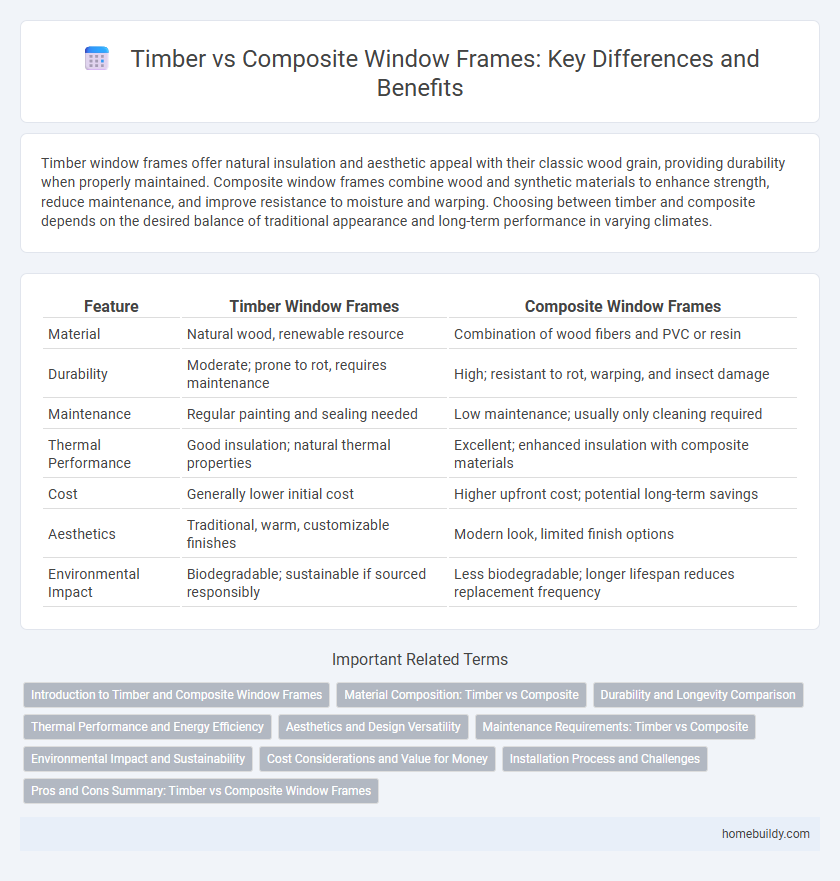Timber window frames offer natural insulation and aesthetic appeal with their classic wood grain, providing durability when properly maintained. Composite window frames combine wood and synthetic materials to enhance strength, reduce maintenance, and improve resistance to moisture and warping. Choosing between timber and composite depends on the desired balance of traditional appearance and long-term performance in varying climates.
Table of Comparison
| Feature | Timber Window Frames | Composite Window Frames |
|---|---|---|
| Material | Natural wood, renewable resource | Combination of wood fibers and PVC or resin |
| Durability | Moderate; prone to rot, requires maintenance | High; resistant to rot, warping, and insect damage |
| Maintenance | Regular painting and sealing needed | Low maintenance; usually only cleaning required |
| Thermal Performance | Good insulation; natural thermal properties | Excellent; enhanced insulation with composite materials |
| Cost | Generally lower initial cost | Higher upfront cost; potential long-term savings |
| Aesthetics | Traditional, warm, customizable finishes | Modern look, limited finish options |
| Environmental Impact | Biodegradable; sustainable if sourced responsibly | Less biodegradable; longer lifespan reduces replacement frequency |
Introduction to Timber and Composite Window Frames
Timber window frames are crafted from natural wood, offering excellent insulation, aesthetic warmth, and the ability to be customized with various finishes. Composite window frames combine materials such as wood fibers and PVC, providing enhanced durability, resistance to moisture and insects, and lower maintenance requirements. Both types serve distinct functional and stylistic needs, with timber emphasizing traditional elegance and composites featuring modern resilience.
Material Composition: Timber vs Composite
Timber window frames consist primarily of natural wood, offering excellent insulation and a traditional aesthetic but requiring regular maintenance to prevent rot and warping. Composite window frames are made from a blend of materials such as wood fibers and PVC or aluminum, providing enhanced durability, resistance to weathering, and lower maintenance needs. The composite material composition allows for improved structural stability and longer lifespan compared to pure timber frames.
Durability and Longevity Comparison
Timber window frames offer natural strength and can last 30 to 50 years with proper maintenance, though they are prone to rot, warping, and insect damage if neglected. Composite window frames, made from a blend of materials like fiberglass and resin, provide superior durability with resistance to moisture, pests, and UV damage, often exceeding 50 years of lifespan. The enhanced stability and low maintenance requirements of composite frames make them a more long-lasting choice compared to traditional timber options.
Thermal Performance and Energy Efficiency
Timber window frames offer natural insulation due to wood's low thermal conductivity, enhancing thermal performance and reducing energy costs. Composite window frames combine materials like wood and PVC, providing superior energy efficiency through increased durability and better resistance to air leakage. Both frame types contribute to improved thermal comfort, but composite frames typically deliver higher long-term energy savings in extreme climates.
Aesthetics and Design Versatility
Timber window frames offer a classic, natural aesthetic with rich grain patterns and the ability to be custom-stained or painted in an extensive range of colors, enhancing traditional and period-style homes. Composite window frames provide greater design versatility through a seamless integration of materials that mimic wood while offering modern finishes and sleek profiles suitable for contemporary architectural styles. Both options allow for customization, but composites excel in providing consistent color and texture with lower maintenance demands.
Maintenance Requirements: Timber vs Composite
Timber window frames require regular maintenance such as sanding, painting, and sealing to prevent rot, warping, and insect damage, especially in humid or rainy climates. Composite window frames, made from materials like uPVC or fiberglass combined with wood fibers, offer enhanced durability with minimal upkeep, needing only occasional cleaning to maintain their appearance. The lower maintenance requirements of composite frames contribute to longer-lasting performance and reduced lifetime costs compared to traditional timber frames.
Environmental Impact and Sustainability
Timber window frames offer a renewable and biodegradable option, sourced from sustainably managed forests that support carbon sequestration and reduce overall environmental impact. Composite window frames, made from recycled materials such as PVC and wood fibers, provide enhanced durability and lower maintenance, extending lifespan and minimizing resource consumption. Both options contribute to sustainability; timber frames excel in natural biodegradability while composites optimize longevity and recycling potential.
Cost Considerations and Value for Money
Timber window frames typically have higher upfront costs due to the quality of natural wood and the craftsmanship required, but they offer excellent insulation and aesthetic appeal that can increase property value. Composite window frames, made from a blend of materials like wood and PVC, provide a more budget-friendly option with low maintenance and strong durability, delivering long-term cost savings. Evaluating cost considerations involves balancing initial investment against lifecycle expenses, where timber frames justify expense through longevity and style, while composite frames maximize value for money with affordability and resilience.
Installation Process and Challenges
Timber window frames require precise measurements and skilled craftsmanship during installation to ensure proper sealing and prevent warping, often demanding longer installation times and specialized tools. Composite window frames offer a more straightforward installation process with prefabricated components designed for easier fitting, reducing labor costs and minimizing errors. Challenges for timber include susceptibility to moisture damage during installation, while composites may face alignment issues due to material flexibility under temperature fluctuations.
Pros and Cons Summary: Timber vs Composite Window Frames
Timber window frames offer natural insulation, aesthetic appeal, and easy customization but require regular maintenance to prevent rot and insect damage. Composite window frames combine wood fibers with PVC or other materials, providing superior durability, low maintenance, and resistance to weathering, though they can be more expensive and less visually authentic than timber. Choosing between timber and composite depends on factors like budget, desired longevity, and maintenance willingness.
Timber window frames vs composite window frames Infographic

 homebuildy.com
homebuildy.com